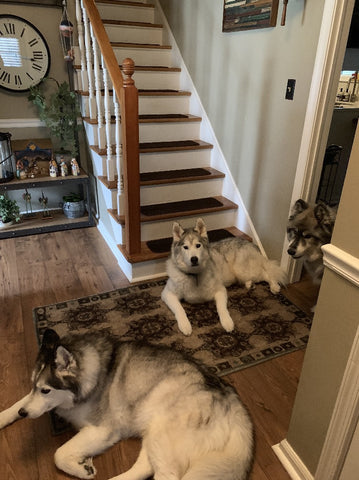Help Your Old Dog Feel Safe and Comfortable as They Age
Posted by Gabrielle Alyse on

Simple Changes You Can Make in Your Home to Help Your Pet
My family had a beautiful German Shepherd when I was growing up. And I still vividly remember the day my dad had to start lifting Zelda's hips to help her get into our minivan.
Whether you adopted an old dog, or your 4-legged friend has grown old with you... It can be hard to admit when your dog isn't as lively as they used to be. Giving extra love and care is one of the best ways we can give them a wonderful life as they transition into a "senior dog."
I hope the tips gathered here are helpful to you, so it's less stressful adjusting to a new way of life with your furry friend. Here's the best part: I asked the vet at my local animal hospital to help make sure you get all the information you need, and that it's accurate. So you'll find a few specific tips listed here from Dr. Vandermause.
You can also download a version of this as a brief checklist to guide the planning for your own home.
How to Make Your Old Dog Comfortable with Soft Places to Lay Down
Treasuring your senior dog and providing a life that brings them joy is a natural desire. But doing that without making your own life stressful can be challenging to balance.
I'm sure that your dog has a cozy bed to sleep in at night, probably with you in your bedroom. What about a soft place for them to lay down in their other favorite spots around your house? Zelda always had a designated spot to lay down while my family ate in our dining room.
As she got older, the bed she had there became a place she went to more and more often. Our open floor-plan meant she could relax in her soft bed, and still keep an eye on my siblings and I in the living room. Maybe in your house, there's a special nook in your kitchen that makes a perfect place for an extra bed for your dog? Koda, my aunt's dog, absolutely loves laying in the sunny patches of her kitchen floor. I suspect they'll add some extra softness there for him to lay on as he ages. A cushy dog bed, a simple mat, or even a small area rug.
Pay attention to what your aging dog tends to prefer, and give them more of that. Zelda seemed to only want her big cushy bed when she was sleeping at night. Otherwise, a cozy mat about a couple inches thick, or just laying down on the carpet in our playroom was good for her.
Even your garage could be a place to add something cozy for your dog to relax on. If you tend to use it as a workshop space, or maybe a man cave like my uncle does... wouldn't it be nice if your dog could enjoy spending time with you out there too? Depending on how polished the concrete floor in your garage is, it might be a little slick for your dog. Having something to lay down on will also make it easier for them to get up since they can grip onto it better than concrete.
Adding beds or mats around the house is an easy, low-effort addition to help your senior dog feel more relaxed. Give them a place to rest that's warm and cozy. It feels much better to their achy body than the cold, hard floor.
Extending the Comfy Spots to Your Outdoor Space
If you have a backyard, is there a special sunny patch of grass they like to lay down in? That's my dog Bailey's spot of choice for her backyard afternoon naps. When I have the opportunity, savoring those moments in the sun giving my dog a little extra love is just about as perfect as life can get.
For those of us whose dogs prefer a stone patio or wooden deck... we might as well make it feel more comfortable for them. Add a weather-friendly dog bed or an outdoor carpet runner. It gives them that supporting cushion underneath as they relax soaking up the sunshine and fresh air. Then, cue some happy sighs from your dog.
Even if you just have a small balcony as your outdoor space, is there a corner your dog might like to lounge in? You could add a small mat or area rug for them there. Or if you're open to it, you can use an outdoor carpet runner to cover the balcony entirely. You just might find your own feet enjoy not feeling the full strength of the cold stone, or the heat after it's soaked up the afternoon sun.
Zelda wasn't allowed to come on our furniture since she was such a big dog. But Bailey, a cocker-spaniel mix, loves nothing more than curling up next to me on a couch. Maybe your dog feels the same way? If you have an outdoor couch or lounge chair that your dog likes to relax on, make sure they feel safe getting up and down from there. Being able to grip onto a skid-resistant rug helps them feel more sure on their feet while climbing onto a couch, or getting down.
Are They Warm Enough? Keeping Your Senior Dog's Body Temperature Regulated
Another change will be paying attention to how changes in the weather might affect your old friend. Fur can thin as dogs age, so they chill easily. There was a time where I was surprised by how many dogs actually love to snuggle up with a blanket. But now... it makes a lot of sense!
If you decide to find a cozy sweater for your senior dog too, I won't tell. But please send pictures so we can appreciate the cuteness. In all seriousness: this is the time where putting coats or sweaters on your dog is totally called for. With less fur, they can't regulate their own body temperature as well as they used to.
Remember I mentioned earlier that you'd see some tips from Dr. Vandermause? He's the head veterinarian at Crystal Mountain Animal Hospital in Austin, Texas, where I'm writing this from.
Dr. Vandermause grew up in the rural farmlands of Wisconsin, where animal care was a part of life from day one. He spent many hours working hands-on with dairy cows, and was particularly inspired when the local veterinarian would visit and tend to a sick or pregnant animal. It was right there on the farm, at only 12 years of age, that Dr. Vandermause made a decision: he wanted to dedicate his life to animal medicine by becoming a licensed veterinarian!
When choosing sweaters, look for "a cotton material that is less likely to be itchy. But whatever material is used, check the skin under it to be sure it's not causing any redness or irritation." - Dr. Vandermause
You might feel wary of going overboard with the blankets and sweaters, but a few here and there will come in handy. If you live in an area where it gets much cooler after sundown, your dog might appreciate a cozy blanket in their bed year-round. Maybe even a light sweater for your walk before bedtime? And if you live in a warm place like Phoenix, Arizona... well, your dog might only need that extra warmth in the winter.
What are Some Ways to Prevent an Old Dog from Slipping On the Floor?
When Zelda first started having trouble standing up, I learned that German Shepherds are known for having hip problems as they age. So that can be one of the first signs that your dog is getting old. A little gray hair, hearing loss, even arthritis - aging is pretty universal, whether you're experiencing it or your dog is.
Part of why it's important to make sure your flooring has enough traction, is being prepared for when your senior dog's back legs start giving out. Arthritis in your dog's back and arthritis in your dog's legs are a couple of the common culprits. Other dogs are challenged with hip displasia as they move into their senior years.
Whatever the cause, it's universally hard to see how painful taking a few steps can be as you watch your dog try to walk. Support your beloved friend with a safe environment as they age. It'll help their anxiety level stay low, and yours.
It's probably scary for your older dog if they slide on hardwood floors, or any other kind of slick flooring. So give them something to grip with their paws and add traction. It's especially important if they're having trouble standing and walking. You don't have to sacrifice your beautiful flooring to help your pet though, don't worry!

Adding rugs of varying sizes with skid-resistant backings helps your senior dog get that extra traction they need. The first place to focus is any walkway your dog frequently uses in your home. How far away is their primary bed from a door to get outside? Are there any slick floors they need to walk across to reach that door before they can get outside to relieve themselves? Little things like this will help you make it easier for your dog to move from one place to another faster. Create a space where they don't need to focus on not slipping while they walk.
It's easy to find what you're looking for. Even if you want to stay small and just address the areas where they walk the most. Or go big and use an area rug to add warmth to seating areas they tend to join you in (on top of the extra traction and cushion under your dog's paws). Area rugs and indoor carpet runners can be coordinated in different colors and patterns to complement the decor you already have in your home. So you can make your home safe for your dog, and keep it beautiful for you!
Proper Nail Care to Reduce the Risk of Slipping
Did you know that if your dog's nails are too long, that can make it easier for them to slip on your floor?
Here's what Dr. Vandermause recommends: "The nails should be trimmed and dremeled every 2 to 4 weeks. When they walk on a hard surface their nails should barely touch the surface and not divert to the side. Trimming and dremeling frequently keeps the blood supply receded so that the length of the nail can be shortened."
"And don't despair if the nails are already too long to trim without bleeding. More frequent pedicures can slowly recede that blood supply. Some dogs that don't tolerate pedicures at home may need to visit the groomer or veterinary clinic for help. I have some patients that require sedation for a proper pedicure. This would need to be addressed by your veterinarian."
If your senior dog needs a little extra help... "Toe-nail grips or booties can be very helpful to improve traction. Just Google: 'toe nail grips for dogs.'"
Ways to Help Your Dog as Changing Levels and Climbing Becomes Intimidating
If you have a multi-level home, your stairs will be one of the first things to check on as you make small changes to support your old dog. Looking down a long flight of stairs, preparing to take that first step down and praying you don't slip and fall... sounds scary, doesn't it? That's likely how your dog feels if your stairs are not already carpeted.

Each step they take down means they have to land their paws in a place that's lower than it was before. Each step up means their paws need to go higher. It's more complicated than just walking forward or backward. And if your dog's vision or depth perception isn't as strong as it used to be... this is one of the most risky situations for your senior dog to be in.
Fully carpeted stairs are a pain to clean. Trying to get the vacuum hose in all the right angles for each step... I don't blame you for wanting to avoid it.
But adding carpet to the steps of your stairs makes a world of difference when your older dog's back legs are giving out. That's why stair treads are pretty much the perfect solution. Your dog gets extra support with navigating the stairs in your home, and your stairs are still easier to clean than being fully carpeted.
"My dogs love going up and down the stairs now. Being 10 years old they were starting to struggle the transit, but the fantastic treads have more than solved the problem." - Donald McHattie
The same challenges with climbing stairs applies to getting in and out of your car. Remember how I mentioned my dad used to lift Zelda's hips so she could get in the minivan? Depending on how big your dog is, they might need a ramp so they can reach the level of your car without you lifting them in and out.
If it's difficult for your senior dog to navigate stairs, you could also add a ramp to your back deck if you have stairs down to the grass. We appreciate being able to make it to our bathrooms with clear signs and easy access. Our dogs appreciate being able to make it to the grass just as easily. Especially when their aging bodies aren't so good at bladder control anymore.
The Mental and Emotional Side of Taking Care of Older Pets
Let's take a minute - watching your dog grow old and struggle with things that used to be easy... it's painful. Sometimes it can be frustrating too, feeling like you're caring for a puppy without the playful energy.
There can be incontinence problems. Your dog can suddenly show a talent for destroying furniture or knocking over garbage bins. As they lose hearing, vision, even sometimes their sense of smell, that can cause some anxiety for your dog. Adjusting to the loss of senses they rely on is alarming to them.

Caring for your aging dog is more than just physical. Keeping them calm and engaged is at least half of it. And while these side effects play out, it can be stressful for you.
No one likes coming home to a mess. Or what about new barking habits, that make phone calls tense? Yeah, definitely not fun. But with preparation and some habit adjusting, you can settle into new routines with your dog.
Watch for Underlying Health Problems
The physical changes in your dog's health and changing anxiety levels can sometimes lead to a new side of your dog's personality taking over. If your dog's behavior seems to be changing, it's a sign for you to check what could be causing that.
"Sometimes behavior changes/issues can be caused by an underlying health problem. This should be addressed at your pet's annual or bi-annual wellness check-up. Senior pets (over 8 years old) should have a blood panel and urinalysis done at least annually. Keep in mind that dogs and cats age at 5 to 7 years to one of ours."
"Good dental hygiene can prevent periodontal disease that causes pain and loss of teeth. (This can contribute to behavior changes as well.) There are a variety of dental care products and can include daily tooth brushing with an enzymatic toothpaste and dental chews that contain products to prevent plaque build-up, but, to be effective, you need to start with a mouth that is free of periodontal disease. This would need to be assessed by your veterinarian and possibly require a thorough teeth cleaning under anesthesia."
While you figure out what could be causing your dog's behavior to change... this is a prime moment to create new routines around what they need.
Adjusting to Behavior and Personality Changes in Your Senior Dog
Maybe running in circles through your living room or rooting through trash cans is how your dog tries to calm themselves down. You love them, but dealing with these changes can also make life stressful for you. So how do you make it easier to manage?
When you leave the house, maybe there's a "home base" your dog stays in. A room prepared just for them. You can remove things that are at risk of getting chewed on. And you can make sure the floor is easy to clean in case of accidents. With a soft bed or mat to lay down on, and a favorite toy, that "home base" can help calm your dog as well.
Carpet runners and area rugs are especially helpful in situations like this. There's something your dog's paws can grab onto better than wood or laminate, and you can easily clean it.
Maybe your dog needs to take it slow, but frequent walks keep them calm. If you can, structure your day so that there's plenty of space for a leisurely stroll or two. And if you're able, maybe a light game of fetch? Even though your dog is getting old, it still helps to make sure they get some exercise to release any extra energy built up throughout the day.
These are just a few ideas, but you can find several online communities with people happy to share the tricks they've learned.
Keeping Them Safe, Warm & Comfortable
At the end of the day, most of us will do just about anything for our pets. They're part of our family, after all.
I hope the suggestions gathered here help you adjust to a new phase of life with your senior dog. Enter your email to download your printable checklist with the recommendations here listed as simple steps in order of priority! You can use that to help get things started, nice and easy.



